August 9, 2023 – In the realm of cloud-based services, Microsoft’s Azure has continually been a beacon of innovation for enterprises, offering an array of cloud-powered capabilities. One of the jewels in its crown is Azure AI Text to Speech—a sophisticated system leveraging the powers of machine learning and artificial intelligence to transmute textual inputs into remarkably lifelike vocal expressions.
Making a notable stride in its pursuit of excellence, Microsoft unveiled an upgraded rendition of Azure AI Text to Speech. Beyond merely broadening the spectrum of supported languages, a new dimension emerged with the introduction of a masculine voice—Ryan Multilingual. This marks a pivotal step towards accommodating diverse user preferences and creating comprehensive, multifaceted user experiences.

Microsoft, in a recent blog post, illuminated the significance of this enhancement. The integration of a male voice ensures that the technology adapts fluidly to various contexts and user inclinations, granting developers the capacity to craft solutions that resonate harmoniously with a wider array of end-users. Remarkably, both of these newly introduced voices encompass an automatic language prediction feature, deftly identifying input text language and adjusting speech output accordingly, sparing the need for manual tagging.
Elevating its language coverage from 14 to an impressive 41, the upgraded Azure AI Text to Speech now embraces an extensive range of linguistic nuances. Languages spanning Arabic, Spanish, German, English, and beyond find their place in this harmonious ensemble of vocal diversity.
Yet, the innovation does not cease there. Microsoft’s engineers have meticulously crafted a novel adaptive system, one that dynamically tweaks AI speech pronunciation, cadence, and phonetic traits, creating a tailor-made resonance with each specific language. As Microsoft aptly puts it, this breakthrough empowers users to fluidly transition between different languages in their textual inputs, cultivating a deeply immersive and authentic multilingual experience.
This triumvirate of novelties—new masculine voice, expanded language support, and the prowess of an adaptive system—currently stands open for public preview in Azure’s Eastern US, Western Europe, and Southeast Asia regions. Microsoft’s stride towards richer, more diverse AI-driven interactions is undeniably propelling the evolution of cloud-based linguistic interactions.












